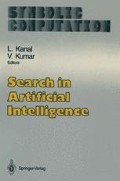Abstract
This paper points out that, since its inception, the basic idea of the General Problem Solver (GPS) has been followed and sharpened by a number of researchers. It describes how their research has shed light on various aspects of GPS, examines their limitations, and tries to remove these limitations. Special consideration is given to work aimed at automating the construction of problem dependent heuristic information guidance for GPS.
The preparation of this paper was partially supported by the National Science Foundation under grant no. DCR-S504223.
Access this chapter
Tax calculation will be finalised at checkout
Purchases are for personal use only
Preview
Unable to display preview. Download preview PDF.
References
A. Newell, J. Shaw and H. Simon, Report on a General Problem Solving Program, Proc. of the Intl. Conference on Information Processing (UNESCO), Paris, 1953, p. 256.
G. Ernst and A. Newell, GPS: A Case Study in Generality and Problem Solving, Academic Press, 1969.
G. Ernst and R. B. Banerji, A Theory for the Complete Mechanization of a GPS-type Problem Solver, Proc. 5th Intl. Joint Conference on Artificial Intelligence, Cambridge, MA, 1977, p. 450.
G. Ernst and M. Goldstein, Mechanical Discovery of Classes of Problem Solving Strategies, Journal of ACM, vol. 29, 1982, p. 1.
F. Hayes-Roth, Collected Papers on the Learning and Recognition of Structured Patterns, Department of Computer Science, Carnegie-Mellon University, 1975.
R. Oyen, Mechanical Discovery of Invariances for Problem Solving, Report 1168, Computer Engineering Department, Case Western Reserve University, 1975.
R. E. Horf, Learning to Solve Problems by Searching for Macro-Operators, Pittman Advanced Publishing Program, Boston, 1985.
R. E. Horf, A Program that Learns to Solve Rubik’s Cube, Proc. of the National Conference on Artificial Intelligence, 1982.
J. Quinlan and E. Hunt, A Formal Deductive Problem Solving System, Journal of ACM, vol. 15, 1968, p. 625.
R. Tikes, P. Hart and N. Nilsson, Learning and Executing Generalized Robot Plans, Artificial Intelligence, vol. 3, 1972, p. 251.
M. Furst, J. Hoperoft and E. Luks, Polynomial Time Algorithms for Permutation Groups, Proc. 21st IEEE Symposium on the Foundations of Computer Science, 1980, P. 36.
M. Jerrum, A Compact Representation for Permutation Groups, Proc. 23rd IEEE Symposium on Foundations of Computer Science, 1982, p. 126.
E. Luks, Isomorphism of Grpahs of bounded Valence Can Be Tested in Polynomial Time, Journal of Computer and System Science, vol. 25, 1982, p. 42.
J. Driscoll and M. Furst, On the Diameters of Permutation Groups, Proc. 15th Annual ACM Symposium on Theory of Computing, 1983, p. 152.
J. A. Eidswick, Cubelike Puzzles—What Are They and How Do You Solve Them?, The American Mathematical Monthly, vol. 93, 1986, p. 157.
P. Hart, N. Nilsson and B. Raphael, A Formal Basis for the Heuristic Determination of Minimal Cost Paths, IEEE Transactions on Systems Science and Cybernetics, vol. SSC-4, 1968, p. 100.
J. Pearl, Heuristics, Addison Wesley, 1984.
D. Ratner and M Warmuth, Finding a Shortest Solution for the n x n Extension of the 15-puzzle is Intractable, Proc. of the 5th National Conference on Artificial Intelligence, 1986, p. 168.
T. Mitchell, P. Utgoff and R. Banerji, Learning by Experimentation: Acquiring and Refinind Problem Solving Heuristics, Machine Learning, (Michalski, Carbonell and Mitchell, eds. ), Tioga Press, 1983.
Pearl, J., On the Discovery and Generation of Certain Heuristics, Report No. UCLA-ENG-CSL-8234, University of California, Los Angeles, 1982.
Author information
Authors and Affiliations
Editor information
Editors and Affiliations
Rights and permissions
Copyright information
© 1988 Springer-Verlag New York Inc.
About this chapter
Cite this chapter
Banerji, R.B., Ernst, G.W. (1988). Developments with GPS. In: Kanal, L., Kumar, V. (eds) Search in Artificial Intelligence. Symbolic Computation. Springer, New York, NY. https://doi.org/10.1007/978-1-4613-8788-6_8
Download citation
DOI: https://doi.org/10.1007/978-1-4613-8788-6_8
Publisher Name: Springer, New York, NY
Print ISBN: 978-1-4613-8790-9
Online ISBN: 978-1-4613-8788-6
eBook Packages: Springer Book Archive

